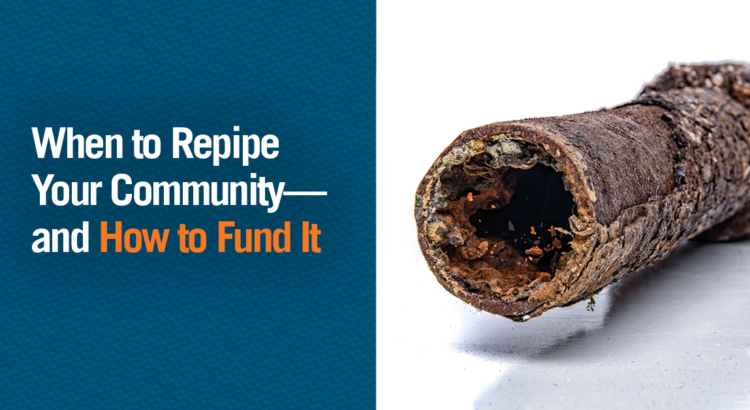When to Repipe Your Community—and How to Fund It
In any condo or apartment community, maintenance and repairs are inevitable. Over time, building materials will begin to fail, and pipes are no exception. Depending on the material, pipes may begin to develop cracks and leaks within a few decades of installation, sometimes less.
The question then becomes: When do you repair the pipe and when do you replace the entire piping system?
Knowing When to Repipe
The decision to repair or replace comes down to one primary factor—money. Essentially: When does the cost to repair become greater than the cost to replace?
The best way to make this determination is to keep careful track of your pipe maintenance and repair using a leak log. Learn more about this process and download the SageWater Leak Log here.
In addition to the straightforward expenses of repairs, you need to consider the less-visible costs. These include:
- Insurance: Catastrophic failures in a piping system and the ensuing costs to repair related damages can cause your insurance rates and deductibles to skyrocket. Eventually, insurers may even cancel your policy and you’ll find it difficult to secure a new carrier. (Learn more about these insurance risks in our previous blog post.)
- Brand reputation: Continual failures in your pipes and damage to individual living units create bad word of mouth. That makes it more difficult for condo owners to sell their units and for apartment managers to rent vacant units quickly.
- Renter turnover: Ongoing piping failures can lead to increased turnover of rental units, adding to your day-to-day costs as a result of reduced occupancy.
- Disgruntled unit owners: Simply put—unhappy condo owners aren’t going to sit quietly, nor should they. The hassle of dealing with complaints and even lawsuits adds up to real dollars quickly.
When the physical costs of ongoing and expected repairs, plus the additional factors of rising insurance rates and turnover costs, are more than the annual financing cost of a repipe, it’s time to replace.
Funding a Condo Repipe
Condo associations can consider four ways to fund a repipe:
- Do you already have the money in your reserves to cover the costs? Often, boards and their management don’t consider piping replacement and other plumbing issues in reserve studies and so no money is on hand to cover the costs.
- If you can’t fund with reserves, is the project small enough that you can comfortably issue a special assessment to cover the costs? Large special assessments can overwhelm owners and residents, potentially forcing them out of the community.
- Favorable lending terms could mean financing is your best option. You might get 15 – 20 years to repay loans for a larger project like pipe replacement, which means you could consider paying off the loan with modest increases to monthly assessments rather than a large special assessment. Even if you’ve reserved for pipe replacement, maybe you’d benefit from taking out a loan and paying it off through reserves. Or, you can take a hybrid approach by pulling from reserves or special assessing part of the cost and financing the rest with a loan.
A couple of other things to keep in mind if you’re association is considering a loan:
- If you’re pre-qualified to borrow more than it costs to repipe, look at bundling projects. You may have several capital improvements that need to be completed and it’s better to bundle them with one larger loan than to take out multiple smaller loans.
- Finally, if you might finance all or part of your project, begin the pre-qualification process as soon as you know you need to repipe. But don’t secure the loan until you have a final scope of work and contract amount since the numbers can change as the scope gets refined.
Funding an Apartment Building Repipe
Financing a repipe for an apartment complex is a little different than for condos. The most common options are:
- Being proactive by saving part of your annual budget every year for a future repipe.
- Owners or buyers discounting the cost of pipe replacement from the property’s price at the time of purchase.
- Refinancing the building/community, freeing up money to repair one or more things at once.
Apartment owners face similar hidden costs of constant repairs as condo owners. Brand reputation can impact your ability to find renters and may prevent you from leasing or raising rents at market rates, putting you further behind in your ability to conduct needed replacements.
Another Worthwhile Consideration
We estimate that more than half of the nation’s multifamily apartment and condo properties are at least 30 years old, which means owners and operators are dealing with dozens of building components and systems that are reaching the end of their useful life. If you own one of these older properties, keep an eye out for emerging or less conventional financing options like grants and other programs geared toward achieving energy and water efficiency. Lower operational costs coupled with the appeal of an environmentally efficient home make for powerful ROI.
Want to learn more about when it’s the right time to repipe your building? Contact SageWater to speak with one of our experts.
We’d love to hear from you.
Thanks for reading our blog! Contact us any time with questions about Simply Smarter Pipe Replacement for multifamily apartment and condominium communities.


